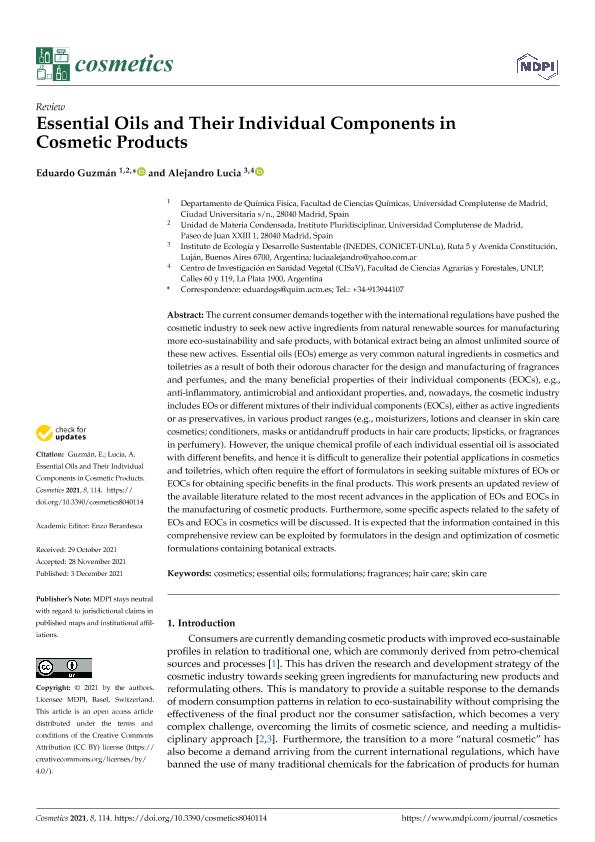Mostrar el registro sencillo del ítem
dc.contributor.author
Guzmán, Eduardo
dc.contributor.author
Lucia, Alejandro

dc.date.available
2023-01-12T13:59:02Z
dc.date.issued
2021-12
dc.identifier.citation
Guzmán, Eduardo; Lucia, Alejandro; Essential oils and their individual components in cosmetic products; Multidisciplinary Digital Publishing Institute; Cosmetics; 8; 4; 12-2021; 1-28
dc.identifier.uri
http://hdl.handle.net/11336/184533
dc.description.abstract
The current consumer demands together with the international regulations have pushed the cosmetic industry to seek new active ingredients from natural renewable sources for manufacturing more eco-sustainability and safe products, with botanical extract being an almost unlimited source of these new actives. Essential oils (EOs) emerge as very common natural ingredients in cosmetics and toiletries as a result of both their odorous character for the design and manufacturing of fragrances and perfumes, and the many beneficial properties of their individual components (EOCs), e.g., anti-inflammatory, antimicrobial and antioxidant properties, and, nowadays, the cosmetic industry includes EOs or different mixtures of their individual components (EOCs), either as active ingredients or as preservatives, in various product ranges (e.g., moisturizers, lotions and cleanser in skin care cosmetics; conditioners, masks or antidandruff products in hair care products; lipsticks, or fragrances in perfumery). However, the unique chemical profile of each individual essential oil is associated with different benefits, and hence it is difficult to generalize their potential applications in cosmetics and toiletries, which often require the effort of formulators in seeking suitable mixtures of EOs or EOCs for obtaining specific benefits in the final products. This work presents an updated review of the available literature related to the most recent advances in the application of EOs and EOCs in the manufacturing of cosmetic products. Furthermore, some specific aspects related to the safety of EOs and EOCs in cosmetics will be discussed. It is expected that the information contained in this comprehensive review can be exploited by formulators in the design and optimization of cosmetic formulations containing botanical extracts.
dc.format
application/pdf
dc.language.iso
eng
dc.publisher
Multidisciplinary Digital Publishing Institute
dc.rights
info:eu-repo/semantics/openAccess
dc.rights.uri
https://creativecommons.org/licenses/by/2.5/ar/
dc.subject
COSMETICS
dc.subject
ESSENTIAL OILS
dc.subject
FORMULATIONS
dc.subject
FRAGRANCES
dc.subject
HAIR CARE
dc.subject
SKIN CARE
dc.subject.classification
Físico-Química, Ciencia de los Polímeros, Electroquímica

dc.subject.classification
Ciencias Químicas

dc.subject.classification
CIENCIAS NATURALES Y EXACTAS

dc.title
Essential oils and their individual components in cosmetic products
dc.type
info:eu-repo/semantics/article
dc.type
info:ar-repo/semantics/artículo
dc.type
info:eu-repo/semantics/publishedVersion
dc.date.updated
2022-09-20T10:21:41Z
dc.identifier.eissn
2079-9284
dc.journal.volume
8
dc.journal.number
4
dc.journal.pagination
1-28
dc.journal.pais
Suiza

dc.journal.ciudad
Basilea
dc.description.fil
Fil: Guzmán, Eduardo. Universidad Complutense de Madrid; España
dc.description.fil
Fil: Lucia, Alejandro. Consejo Nacional de Investigaciones Científicas y Técnicas. Oficina de Coordinación Administrativa Parque Centenario. Universidad Nacional de Luján. Instituto de Ecología y Desarrollo Sustentable; Argentina. Universidad Nacional de La Plata. Facultad de Ciencias Agrarias y Forestales. Centro de Investigación de Sanidad Vegetal; Argentina
dc.journal.title
Cosmetics
dc.relation.alternativeid
info:eu-repo/semantics/altIdentifier/url/https://www.mdpi.com/2079-9284/8/4/114
dc.relation.alternativeid
info:eu-repo/semantics/altIdentifier/doi/http://dx.doi.org/10.3390/cosmetics8040114
Archivos asociados
